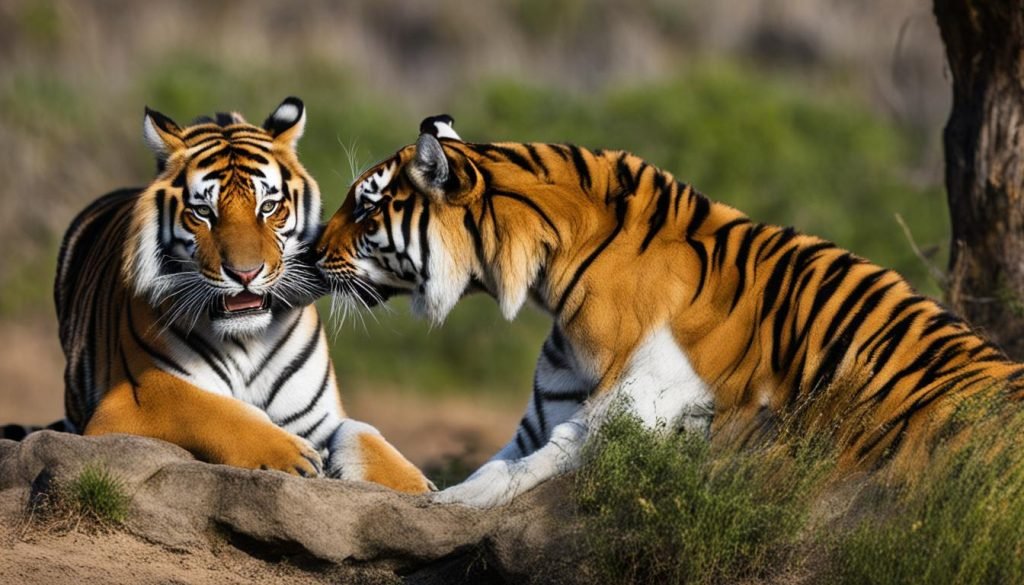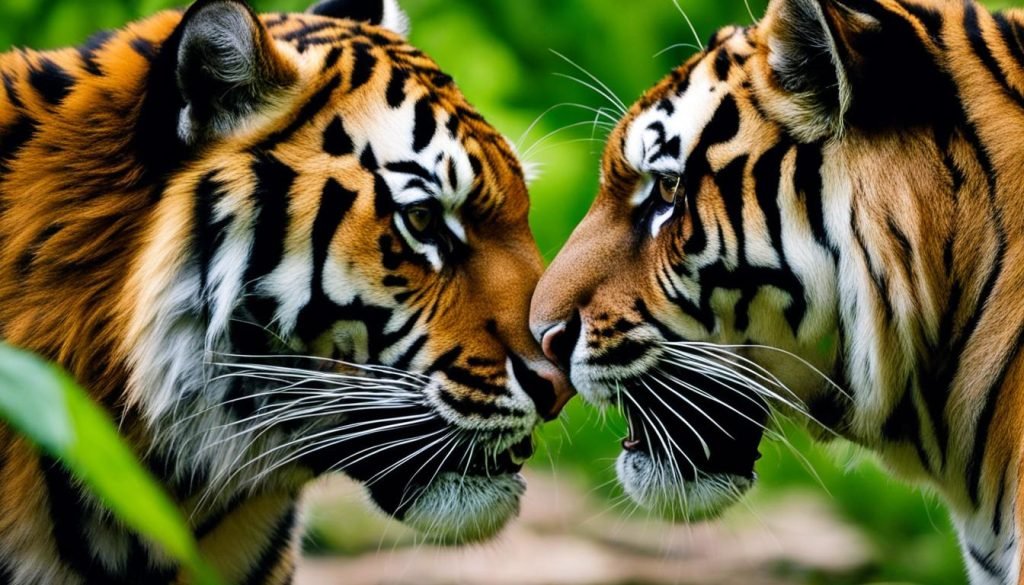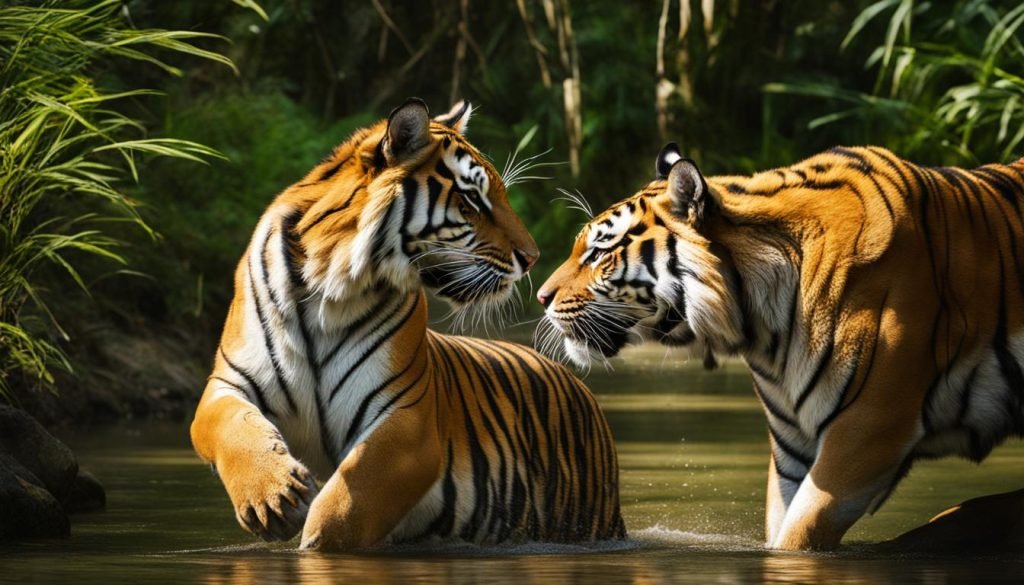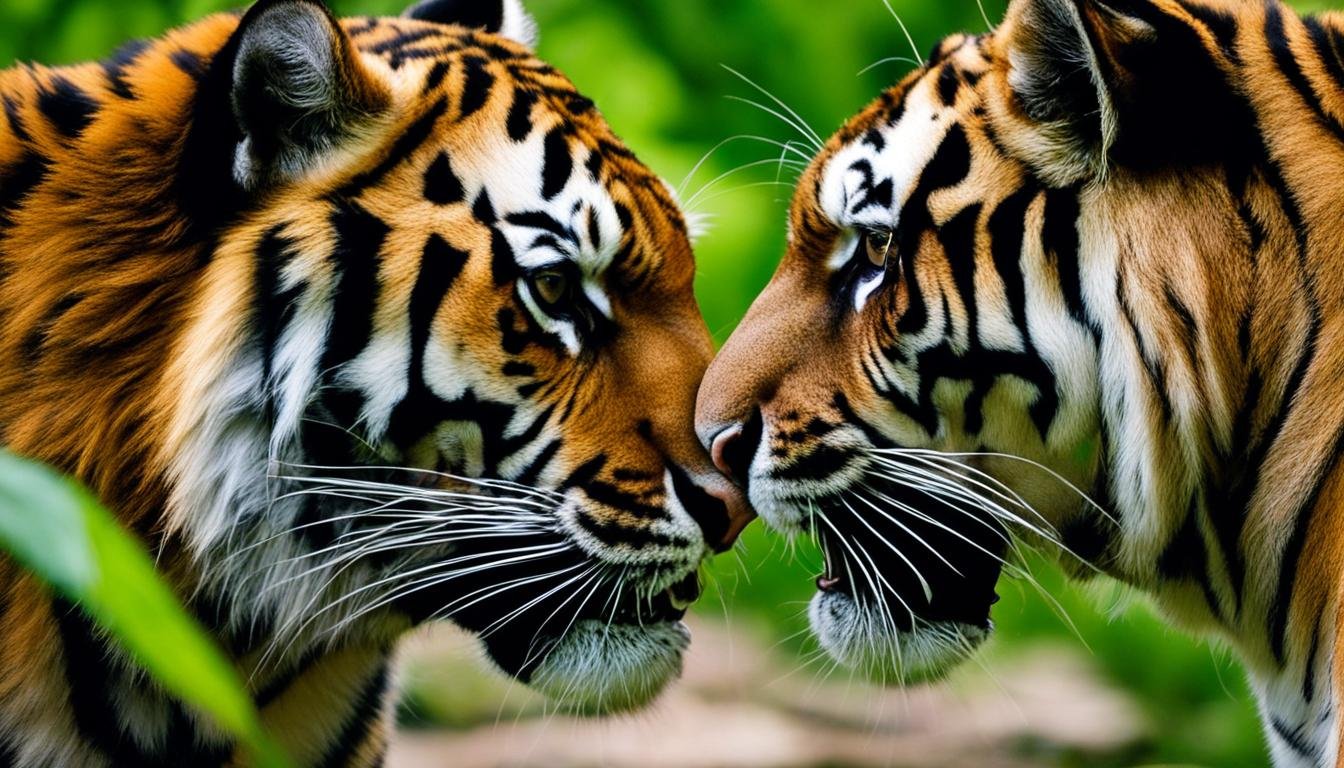How Do Tigers Mate? – Reproduction Explained
When it comes to tiger mating behaviors, there are many intricacies to consider. From courtship rituals to mate selection and mating patterns, the process is complex and fascinating. In this section, we will take a deep dive into the tiger reproduction process and uncover the secrets behind how these majestic creatures mate.
Tigers are known for their impressive size and strength, but their reproductive practices are equally impressive. These big cats engage in elaborate courtship rituals, and their mate selection process is highly specific. Understanding these behaviors can provide valuable insights into the lives of tigers and their conservation needs.
Let’s explore some of the key aspects of tiger mating behaviors and reproduction.
Key Takeaways:
- Tigers engage in elaborate courtship rituals as part of their reproductive cycle.
- Tigers have specific criteria when it comes to selecting their mates, including physical traits and social dynamics.
- Tigers exhibit specific mating patterns that are influenced by various factors, including timing and individual preferences.
- The reproduction process of tigers involves a series of events and adaptations, including mating, gestation, and the birth of cubs.
- The mating behaviors of tigers can differ between those in their natural habitat and those in captivity.
Understanding Tiger Courtship Rituals

Tigers are known for their elaborate courtship rituals, which are an essential part of their reproductive cycle. These rituals involve a series of behaviors and displays that tigers use to attract potential mates and establish social and territorial status.
During courtship, tigers engage in a range of behaviors, from vocalizations and scent marking to physical displays of dominance and submission. These behaviors vary based on factors such as age, sex, and social status.
The courtship ritual typically begins with a female marking her territory with urine, signaling her readiness to mate. Male tigers will then roam the area, leaving their own scent marks as they search for potential mates.
Once a male tiger has identified a female, he will begin to display his strength and dominance through vocalizations such as growls and roars. He may also engage in physical displays such as rubbing his head and body against the female or nipping at her neck.
The female tiger may respond to the male’s displays with her own vocalizations and physical responses, such as rolling on the ground or crouching in a submissive posture. This behavior communicates her willingness to mate and establishes the male’s dominance.
Once the male and female have established their social status and readiness to mate, they will engage in copulation. After mating, the female will typically give birth to a litter of cubs within three to four months.
“Tigers engage in a range of behaviors, from vocalizations and scent marking to physical displays of dominance and submission.”
Tiger Quiz
How well do you know tigers? Test your knowledge below!

Unveiling Tiger Mate Selection

Tiger mate selection is a complex process that is influenced by various factors such as territorial behavior, physical traits, and social dynamics among individuals.
Territorial behavior: Tigers are territorial animals and will choose mates that are within their territory. This helps ensure the survival of their offspring by reducing competition for resources. Male tigers, in particular, will select mates based on the size and quality of their territory.
Physical traits: Tigers will also choose mates based on their physical traits. Male tigers will prefer females with certain physical characteristics, such as a healthy coat, strong jawline, and clear eyes. On the other hand, female tigers will select mates based on the male’s physical strength and dominance.
| Physical Traits | Male Preference | Female Preference |
|---|---|---|
| Healthy coat | X | |
| Strong jawline | X | |
| Clear eyes | X | |
| Physical strength | X | |
| Dominance | X |
Social dynamics: The social dynamics of tigers are also an essential factor when it comes to mate selection. Tigers are solitary animals, and females will select mates that will protect them and their cubs. Males will choose females that will provide them with the opportunity to mate and pass on their genes.
Tiger mating practices also involve courtship rituals, whereby males will perform various behaviors to attract females. These include marking their territory with urine, vocalizations, and physical displays like rubbing their cheeks or spraying saliva.
Understanding tiger mate selection and mating practices is crucial to conserving these magnificent creatures. By keeping their natural habitats intact and reducing human-wildlife conflict, we can help ensure the survival of these endangered species.
Understanding Tiger Mating Patterns

Tigers exhibit specific mating patterns that are influenced by a variety of factors, including their social dynamics, territorial behavior, and individual preferences. Let’s take a closer look at some of the key mating patterns observed in tigers:
| Mating Pattern | Description |
|---|---|
| Monogamy | Some tigers form long-lasting pair bonds and mate exclusively with one partner. |
| Polygamy | Many tigers engage in polygamous mating, where a male mates with multiple females. This behavior is often seen in dominant males who control large territories. |
| Indiscriminate Mating | Some tigers will mate with any available partner, with little regard for social status or territorial boundaries. This behavior is often associated with young, inexperienced tigers. |
The timing and frequency of tiger mating also vary depending on several factors. For instance, female tigers are only receptive to mating for a few days each year during their estrus cycle. Male tigers may roam long distances in search of potential mates or actively defend their territory to attract females.
Tiger breeding habits also differ depending on their environment. Tigers in captivity may exhibit different mating patterns, such as a lower frequency of mating due to stress and limited resources.
“Tigers exhibit unique and complex mating behaviors that are influenced by various factors, including their social dynamics, territorial behavior, and individual preferences.”
The Significance of Tiger Mating Patterns
Understanding tiger mating patterns is crucial for conservation efforts and species management. By monitoring these behaviors, researchers can gain insights into the population dynamics of tigers and their breeding habits. This information can be used to develop effective conservation strategies and protect these magnificent creatures from extinction.
Exploring the Tiger Reproduction Process

After the courtship rituals and mate selection process, the actual tiger reproduction process begins. This process involves a series of events that are essential for the birth of healthy cubs.
The first step in the reproduction process is mating, which usually occurs during the tiger mating season. This season typically takes place in the winter months when the temperatures are cooler and prey is abundant. During this time, tigers become more active and aggressive in their pursuit of mates.
Once mating has occurred, the female tiger undergoes a gestation period of around 103 days. During this time, she will prepare a den to give birth to her cubs. The den is usually located in a secluded area, such as a dense thicket or cave, to protect the cubs from predators. The female will also stop hunting during this time, relying on the male to bring her food.
After the gestation period, the female gives birth to a litter of cubs, typically consisting of 2-4 individuals. The cubs are born blind and helpless, weighing only around 2-3 pounds each. The mother will nurse her cubs for the first few months, and the male may help to protect the den and bring food to the family.
As the cubs grow older, they will start to venture outside of the den and develop their hunting skills. They will continue to nurse for several months but will eventually transition to eating solid food. The family will stay together for around 2-3 years before the cubs become independent and leave to establish their own territories.
Overall, the tiger reproduction process is a complex and fascinating journey, from the courtship rituals to the birth of cubs. By understanding this process, we can gain a greater appreciation for the natural behaviors and adaptations of these majestic creatures.
Tiger Mating Behaviors: Nature vs. Captivity
Tigers are known for their impressive mating behaviors, which vary depending on various factors, including their environment. While tigers in their natural habitat exhibit behaviors that are influenced by their social dynamics and territorial tendencies, those in captivity may display different behaviors due to stress, isolation, or other factors.
Studies have shown that tigers in captivity, particularly those kept alone, can experience a range of stress-related behaviors, such as pacing back and forth, vocalizing, and self-mutilation. These behaviors can have a significant impact on their mating practices, making it challenging to observe and study their natural breeding habits.
On the other hand, tigers in the wild engage in complex courtship rituals before mating, involving behaviors such as vocalizations, scent marking, and physical displays. These behaviors are critical to attracting potential mates and ensuring a successful breeding process.
While conservation efforts have helped preserve and protect tiger populations in captivity, it is essential to understand the impact of their environment on their mating behaviors. By studying the similarities and differences between tiger mating in nature and captivity, we can gather valuable insights into their behavior and develop strategies to support their conservation efforts.
“The mating behaviors of tigers can differ between those in their natural habitat and those in captivity.”
Tiger Mating Behaviors: Factors to Consider
When comparing tiger mating behaviors in nature and captivity, it is essential to consider various factors that can influence their behavior. These factors include:
- Environmental conditions
- Social dynamics
- Territorial behavior
- Stress and isolation
- Availability of mates
By examining these factors, we can gain a better understanding of the complex nature of tiger mating behaviors and how they are influenced by their environment. This knowledge can help us develop effective conservation strategies to preserve and protect these magnificent creatures.
Conclusion: Gaining Insight into Tiger Mating
Through our exploration of tiger mating practices and mating patterns, we have gained a greater understanding of these magnificent creatures’ reproductive practices. Tigers engage in elaborate courtship rituals and have distinct criteria for selecting their mates. The timing, frequency, and individual preferences also play a significant role in tiger mating.
By understanding the complexities of tiger reproduction, we can better appreciate the importance of conservation efforts aimed at preserving their habitats. As human activity continues to encroach on tiger territories, it is vital to protect these creatures’ mating habits and prevent any disruption of their natural reproductive behaviors.
The Significance of Tiger Mating Practices
As one of nature’s most powerful predators, tigers play a crucial role in maintaining the balance of ecosystems. Understanding their mating behaviors can help us conserve their populations and ensure their survival for future generations.
The Future of Tiger Mating Patterns
The study of tiger mating practices and patterns is an ongoing field of research. As we gain more knowledge, we can continue to refine conservation efforts and protect these incredible creatures for years to come.
Overall, by unlocking the mysteries of tiger mating, we gain a deeper appreciation for their complex behaviors and the importance of preserving their populations.
More About Tigers:
- What Do Tigers Eat? – A Comprehensive Guide
- How Long Do Tigers Live? Exploring Lifespans
- 15 Facts About Tigers That Will Surprise You
- Tiger Quiz: How Well Do You Know Tigers?
Frequently Asked Questions
How do tigers mate?
Tigers mate through a process called copulation, where the male tiger mounts the female from behind and assumes a specific position. This allows for the successful transfer of sperm and increases the chances of fertilization.
What are some tiger courtship rituals?
Tiger courtship rituals involve various behaviors that help attract potential mates. These rituals can include vocalizations, rubbing against trees or objects to mark territory, and displays of physical prowess such as roaring or posturing.
How do tigers select their mates?
Tigers select their mates based on various factors. These can include dominance hierarchies among individuals, physical traits such as size and strength, and social dynamics within the tiger population.
What are some tiger mating patterns?
Tigers exhibit different mating patterns, which can vary in terms of timing, frequency, and individual preferences. Some tigers may mate only during specific seasons, while others may engage in mating throughout the year.
What is the tiger reproduction process?
The tiger reproduction process involves several stages, starting with courtship and copulation. After successful mating, the female tiger undergoes a gestation period of around 100 days before giving birth to a litter of cubs.
How do tiger mating behaviors differ between nature and captivity?
Tiger mating behaviors can differ between those in their natural habitat and those in captivity. Factors such as social dynamics, stress levels, and the presence of conservation efforts can influence the mating behaviors observed in these different environments.
What insights can we gain from studying tiger mating practices?
By studying tiger mating practices, we can gain valuable insights into their reproductive strategies, social dynamics, and the conservation efforts needed to protect these magnificent creatures. Understanding their mating behaviors can contribute to conservation efforts and the preservation of tiger populations.







